When Time Prevails: The Perils of Overlooking Temporal Landscape Evolution in Landslide Susceptibility Predictions
Abstract
1. Introduction
2. Materials and Methods
2.1. Study Area and Temporal Scenario Construction
2.2. Generation of Artificial Digital Elevation Models (ADEMs)
2.3. Morphometric Indices Extraction
2.4. Land Use/Cover Change Analysis
2.4.1. Degradation Phase (1960–1980)
2.4.2. Rehabilitation Phase (Post-1980)
2.5. Reconstruction of Historical Road Networks
2.6. Integration of Temporal Changes into Susceptibility Modeling
2.7. Landslide Susceptibility Modeling
2.7.1. Modeling Scenarios
- Strategized Modeling: Incorporates historical LULC and morphometric data across all ADEMs, providing a temporally integrated model.
- Blind Modeling: Relies solely on current data, representing a static approach commonly used in conventional LSA.
2.7.2. Model Calibration and Validation
2.8. Evaluation of Model Differences and Temporal Effects
3. Results
3.1. Temporal Evolution of Landscape and Landslide Susceptibility Patterns
3.2. Comparison of Strategized and Blind Models in Susceptibility Mapping
3.3. Temporal Sensitivity of Morphometric and Environmental Factors
3.3.1. Digital Elevation Model (DEM)
3.3.2. Slope Length (LS) Factor
3.3.3. Convergence Index
3.3.4. Profile Curvature
3.3.5. Topographic Position Index (TPI)
3.3.6. Rainfall
3.3.7. Distance from Roads
3.3.8. Distance from Streams
3.3.9. Land Use and Land Cover (LULC)
3.4. Model Performance Evaluation Results
4. Discussion
4.1. Summary of Morphometric and Environmental Sensitivity Analysis
4.2. Implications for Landslide Susceptibility Assessment and Risk Management
4.3. Limitations of Slope Units and Buffering in Capturing Temporal Dynamics
4.4. Creating Multi-Temporal Thematic Maps: A Comprehensive Solution to Model Temporal Dynamics
4.5. Reassessing Susceptibility Model Robustness in Light of Temporal Dynamics
4.6. The Danger of Oversimplification: Moving Beyond the Static-to-Hazard Paradigm in Susceptibility Mapping
4.7. Limitations and Future Directions
4.8. Comparison with Other Works
5. Concluding Remarks
- The development of a temporally integrated susceptibility model that incorporates historical landscape dynamics leads to more accurate landslide susceptibility maps compared to static models, which fail to account for temporal changes. This results in a better reflection of the real conditions influencing landslide susceptibility.
- Traditional static modeling approaches were shown to be inadequate, as they do not consider how the landscape evolves over time. This omission can cause significant errors, such as false positives and false negatives, which undermine the effectiveness of susceptibility mapping.
- The study proposes the need for a new evaluation framework that incorporates multiple temporal instances. This approach would offer a more comprehensive understanding of how susceptibility evolves over time and how models can be better assessed across different timeframes.
- We highlighted the roles of remote sensing, GIS, and data reconstruction technologies in creating multi-temporal thematic maps. These technologies provide researchers with the tools necessary to better capture landscape dynamics and enhance the accuracy of susceptibility assessments.
- The assumption that the current conditions alone are sufficient to represent landslide susceptibility is challenged. The research emphasizes the importance of incorporating past degradation, recovery, and human interventions into susceptibility modeling, as they contribute to the overall landscape dynamics that influence landslide susceptibility.
- The study advocates a dynamic approach to modeling landslide susceptibility by considering variables such as rainfall intensity, vegetation cover, and soil moisture. This inclusion makes the model more reliable and resilient to varying environmental conditions, improving its predictive power.
- Temporally integrated susceptibility models can improve landslide risk management strategies. This approach allows for more accurate and confident decision-making, ultimately leading to better risk reduction and more effective protection for communities in landslide-prone areas.
- Highlighting the risks of the traditional static-to-hazard approach, this study argues for embedding temporal dynamics directly into susceptibility modeling, emphasizing that integrating temporal factors within the susceptibility stage itself ensures more accurate and realistic landslide susceptibility assessments.
Author Contributions
Funding
Data Availability Statement
Conflicts of Interest
References
- Chalkias, C.; Ferentinou, M.; Polykretis, C. Landslide Risk Assessment, Awareness, and Risk Mitigation: Case Studies. In Landslide Science for a Safer Geoenvironment; Springer: Berlin/Heidelberg, Germany, 2014; pp. 15–30. [Google Scholar] [CrossRef]
- Shano, L.; Raghuvanshi, T.K.; Meten, M. Landslide susceptibility evaluation and hazard zonation techniques—A review. Geoenviron. Disasters 2020, 7, 18. [Google Scholar] [CrossRef]
- Pourghasemi, H.R.; Sadhasivam, N.; Amiri, M.; Eskandari, S.; Santosh, M. Landslide susceptibility assessment and mapping using state-of-the-art machine learning techniques. Nat. Hazards 2021, 108, 1291–1316. [Google Scholar] [CrossRef]
- Luo, Y.; Wang, J.; Zhang, L. Evaluating landslide susceptibility: An AHP method-based approach. Nat. Hazards 2023, 110, 45–60. [Google Scholar] [CrossRef]
- Wang, T.; Dahal, A.; Fang, Z.; van Westen, C.; Yin, K.; Lombardo, L. From spatio-temporal landslide susceptibility to landslide risk forecast. Geosci. Front. 2024, 15, 101765. [Google Scholar] [CrossRef]
- Lee, S.; Pradhan, B. Landslide hazard mapping at Selangor, Malaysia using frequency ratio and logistic regression models. Landslides 2007, 4, 33–41. [Google Scholar] [CrossRef]
- Yang, S.; Tan, J.; Luo, D.; Wang, Y.; Guo, X.; Zhu, Q.; Ma, C.; Xiong, H. Sample size effects on landslide susceptibility models: A comparative study of heuristic, statistical, machine learning, deep learning and ensemble learning models with SHAP analysis. Comput. Geosci. 2024, 193, 105723. [Google Scholar] [CrossRef]
- Bui, D.T.; Tuan, T.A.; Klempe, H.; Pradhan, B.; Revhaug, I. Spatial prediction models for shallow landslide hazards: A comparative assessment of the efficacy of support vector machines, artificial neural networks, kernel logistic regression, and logistic model tree. Landslides 2016, 13, 361–378. [Google Scholar] [CrossRef]
- Youssef, A.M.; Pourghasemi, H.R.; Pourtaghi, Z.S. Landslide susceptibility mapping using random forest, boosted regression tree, classification and regression tree, and general linear models and comparison of their performance at Wadi Tayyah Basin, Asir Region, Saudi Arabia. Landslides 2016, 13, 839–856. [Google Scholar] [CrossRef]
- Dou, J.; Yunus, A.P.; Bui, D.T.; Merghadi, A.; Sahana, M.; Zhu, Z.; Pham, B.T. Improved landslide assessment using support vector machine with bagging, boosting, and stacking ensemble machine learning framework in a mountainous watershed, Japan. Landslides 2020, 17, 641–658. [Google Scholar] [CrossRef]
- Pham, B.T.; Prakash, I.; Bui, D.T. Spatial prediction of landslides using a hybrid machine learning approach based on random subspace and classification and regression trees. Geomorphology 2018, 303, 256–270. [Google Scholar] [CrossRef]
- Hong, H.; Liu, J.; Bui, D.T.; Pradhan, B.; Acharya, T.D.; Pham, B.T.; Ahmad, B.B. Landslide susceptibility mapping using J48 Decision Tree with AdaBoost, Bagging and Rotation Forest ensembles in the Guangchang area (China). Catena 2018, 163, 399–413. [Google Scholar] [CrossRef]
- Chen, W.; Xie, X.; Wang, J.; Pradhan, B.; Hong, H.; Bui, D.T.; Ma, J. A comparative study of logistic model tree, random forest, and classification and regression tree models for spatial prediction of landslide susceptibility. Catena 2017, 151, 147–160. [Google Scholar] [CrossRef]
- Zeng, T.; Jin, B.; Glade, T.; Xie, Y.; Li, Y.; Zhu, Y.; Yin, K. Assessing the imperative of conditioning factor grading in machine learning-based landslide susceptibility modeling: A critical inquiry. Catena 2024, 236, 107732. [Google Scholar] [CrossRef]
- Guo, W.; Ye, J.; Liu, C.; Lv, Y.; Zeng, Q.; Huang, X. An approach for predicting landslide susceptibility and evaluating predisposing factors. Int. J. Appl. Earth Obs. Geoinf. 2024, 135, 104217. [Google Scholar] [CrossRef]
- Xiao, L.; Zhang, Y.; Peng, G. Landslide susceptibility assessment using integrated deep learning algorithm along the China-Nepal highway. Sensors 2018, 18, 4436. [Google Scholar] [CrossRef]
- Chen, W.; Hong, H.; Panahi, M.; Shahabi, H.; Wang, Y.; Shirzadi, A.; Bin Ahmad, B. Spatial prediction of landslide susceptibility using GIS-based data mining techniques of ANFIS with whale optimization algorithm (WOA) and grey wolf optimizer (GWO). Appl. Sci. 2019, 9, 3755. [Google Scholar] [CrossRef]
- Huqqani, I.A.; Tay, L.T.; Mohamad-Saleh, J. Spatial landslide susceptibility modelling using metaheuristic-based machine learning algorithms. Eng. Comput. 2023, 39, 867–891. [Google Scholar] [CrossRef]
- Thirugnanam, H. Deep learning in landslide studies: A review. In Progress in Landslide Research and Technology; Springer: Berlin/Heidelberg, Germany, 2023; pp. 247–255. [Google Scholar] [CrossRef]
- Liu, Q.; Norbu, N. Modeling of landslides susceptibility prediction using deep belief networks with optimized learning rate control. Geocarto Int. 2024, 39, 2322060. [Google Scholar] [CrossRef]
- Segoni, S.; Pappafico, G.; Luti, T.; Catani, F. Landslide susceptibility assessment in complex geological settings: Sensitivity to geological information and insights on its parameterization. Landslides 2020, 17, 2443–2453. [Google Scholar] [CrossRef]
- O’Sullivan, A.M.; Devito, K.J.; Curry, R.A. The influence of landscape characteristics on the spatial variability of river temperatures. Catena 2019, 177, 70–83. [Google Scholar] [CrossRef]
- Quevedo, R.P.; Velastegui-Montoya, A.; Montalván-Burbano, N.; Morante-Carballo, F.; Korup, O.; Daleles Rennó, C. Land use and land cover as a conditioning factor in landslide susceptibility: A literature review. Landslides 2023, 20, 967–982. [Google Scholar] [CrossRef]
- Alcántara-Ayala, I.; Sassa, K. Landslide risk management: From hazard to disaster risk reduction. Landslides 2023, 20, 2031–2037. [Google Scholar] [CrossRef]
- Capobianco, V.; Choi, C.E.; Crosta, G.; Hutchinson, D.J.; Jaboyedoff, M.; Lacasse, S.; Nadim, F.; Reeves, H. Effective landslide risk management in era of climate change, demographic change, and evolving societal priorities. Landslides 2025, 1–19. [Google Scholar] [CrossRef]
- Fang, Z.; Wang, Y.; van Westen, C.; Lombardo, L. Space–time landslide susceptibility modeling based on data-driven methods. Math. Geosci. 2024, 56, 1335–1354. [Google Scholar] [CrossRef]
- Tyagi, A.; Gupta, N.; Tiwari, R.K.; James, N.; Chavan, S.R. Determining the impact of anthropogenic activities and climate change on landslide susceptibility for the Himalayan region. Nat. Hazards 2024, 108, 1291–1316. [Google Scholar] [CrossRef]
- Görüm, T.; Tanyas, H.; Karabacak, F.; Yılmaz, A.; Girgin, S.; Allstadt, K.E.; Burgi, P. Preliminary documentation of coseismic ground failure triggered by the February 6, 2023 Türkiye earthquake sequence. Eng. Geol. 2023, 327, 107315. [Google Scholar] [CrossRef]
- Karakas, G.; Unal, E.O.; Cetinkaya, S.; Özcan, N.T.; Karakas, V.E.; Can, R.; Kocaman, S. Analysis of landslide susceptibility prediction accuracy with an event-based inventory: The 6 February 2023 Türkiye earthquakes. Soil Dyn. Earthq. Eng. 2024, 178, 108491. [Google Scholar] [CrossRef]
- Kocaman, S.; Çetinkaya, S.; Özcan, N.T.; Karakaş, G.; Karakaş, V.E.; Gökçeoğlu, C. Landslides triggered by the 6 February 2023 Kahramanmaraş earthquakes (Türkiye). Turk. J. Earth Sci. 2025, 34, 47–67. [Google Scholar] [CrossRef]
- Han, Y.; Semnani, S.J. Important considerations in machine learning-based landslide susceptibility assessment under future climate conditions. Acta Geotech. 2024, 20, 475–500. [Google Scholar] [CrossRef]
- Mishra, M. Modeling and Information Reconstruction from Landslide Monitoring Data. Ph.D. Thesis, Université Grenoble Alpes, Grenoble, France, 2022. [Google Scholar]
- Liu, D.; Gong, X.; Hu, X.; Wang, H.; Zheng, W.; Niu, L. Displacement field reconstruction in landslide physical modeling by using a terrain laser scanner–Part 1: Methodology, error analysis and validation. J. Rock Mech. Geotech. Eng. 2024, 16, 4066–4076. [Google Scholar] [CrossRef]
- Cascini, L.; Ciurleo, M.; Di Nocera, S. Soil depth reconstruction for the assessment of the susceptibility to shallow landslides in fine-grained slopes. Landslides 2017, 14, 459–471. [Google Scholar] [CrossRef]
- Gupta, S.K.; Shukla, D.P. Application of drone for landslide mapping, dimension estimation and its 3D reconstruction. J. Indian Soc. Remote Sens. 2018, 46, 903–914. [Google Scholar] [CrossRef]
- Ayalew, L.; Yamagishi, H. The application of GIS-based logistic regression for landslide susceptibility mapping in the Kakuda-Yahiko Mountains, Central Japan. Geomorphology 2005, 65, 15–31. [Google Scholar] [CrossRef]
- Conoscenti, C.; Di Maggio, C.; Rotigliano, E. GIS analysis to assess landslide susceptibility in a fluvial basin, southern Sicily. Geomorphology 2008, 94, 325–339. [Google Scholar] [CrossRef]
- Nefeslioglu, H.A.; Gokceoglu, C.; Sonmez, H. An assessment on the use of logistic regression and artificial neural networks with different sampling strategies for the preparation of landslide susceptibility maps. Eng. Geol. 2008, 97, 171–191. [Google Scholar] [CrossRef]
- Pradhan, B.; Lee, S. Regional landslide susceptibility analysis using back-propagation neural network model at Cameron Highland, Malaysia. Landslides 2010, 7, 13–30. [Google Scholar] [CrossRef]
- Mandal, S.; Mondal, S. Geomorphic Diversity and Landslide Susceptibility: A Multi-criteria Evaluation Approach. In Geoinformatics and Modelling of Landslide Susceptibility and Risk: An RS & GIS-Based Model Building Approach in the Eastern Himalaya; Springer: Cham, Switzerland, 2019; pp. 73–120. [Google Scholar] [CrossRef]
- Barbosa, N.; Andreani, L.; Gloaguen, R.; Ratschbacher, L. Window-based morphometric indices as predictive variables for landslide susceptibility models. Remote Sens. 2021, 13, 451. [Google Scholar] [CrossRef]
- Chicas, S.D.; Li, H.; Mizoue, N.; Ota, T.; Du, Y.; Somogyvári, M. Landslide susceptibility mapping core-base factors and models’ performance variability: A systematic review. Nat. Hazards 2024, 120, 12573–12593. [Google Scholar] [CrossRef]
- Sonker, I.; Tripathi, J.N.; Swarnim. Landslide susceptibility mapping using morphological and hydrological parameters in Sikkim Himalaya: Frequency ratio model and geospatial technologies. Nat. Hazards 2024, 120, 6797–6832. [Google Scholar] [CrossRef]
- Phillips, S.J.; Dudík, M.; Schapire, R.E. A maximum entropy approach to species distribution modeling. In Proceedings of the Twenty-First International Conference on Machine Learning, Banff, AB, Canada, 4–8 July 2004; p. 83. [Google Scholar] [CrossRef]
- Phillips, S.J.; Anderson, R.P.; Schapire, R.E. Maximum entropy modeling of species geographic distributions. Ecol. Model. 2006, 190, 231–259. [Google Scholar] [CrossRef]
- Phillips, S.J. A brief tutorial on Maxent. T. Res. 2005, 190, 231–259. Available online: http://biodiversityinformatics.amnh.org/open_source/maxent/ (accessed on 3 September 2024). [CrossRef]
- Phillips, S.J.; Dudík, M. Modeling of species distributions with Maxent: New extensions and a comprehensive evaluation. Ecography 2008, 31, 161–175. [Google Scholar] [CrossRef]
- Elith, J.; Phillips, S.J.; Hastie, T.; Dudík, M.; Chee, Y.E.; Yates, C.J. A statistical explanation of MaxEnt for ecologists. Divers. Distrib. 2011, 17, 43–57. [Google Scholar] [CrossRef]
- Kornejady, A.; Ownegh, M.; Bahremand, A. Landslide susceptibility assessment using maximum entropy model with two different data sampling methods. Catena 2017, 152, 144–162. [Google Scholar] [CrossRef]
- Metz, C.E. Basic principles of ROC analysis. Semin. Nucl. Med. 1978, 8, 283–298. [Google Scholar] [CrossRef]
- Obuchowski, N.A. ROC analysis. Am. J. Roentgenol. 2005, 184, 364–372. [Google Scholar] [CrossRef]
- Gorsevski, P.V.; Gessler, P.E.; Foltz, R.B.; Elliot, W.J. Spatial prediction of landslide hazard using logistic regression and ROC analysis. Trans. GIS 2006, 10, 395–415. [Google Scholar] [CrossRef]
- Cantarino, I.; Carrion, M.A.; Goerlich, F.; Martinez Ibañez, V. A ROC analysis-based classification method for landslide susceptibility maps. Landslides 2019, 16, 265–282. [Google Scholar] [CrossRef]
- Sahin, E.K.; Colkesen, I.; Kavzoglu, T. A comparative assessment of canonical correlation forest, random forest, rotation forest and logistic regression methods for landslide susceptibility mapping. Geocarto Int. 2020, 35, 341–363. [Google Scholar] [CrossRef]
- Yang, C.; Liu, L.L.; Huang, F.; Huang, L.; Wang, X.M. Machine learning-based landslide susceptibility assessment with optimized ratio of landslide to non-landslide samples. Gondwana Res. 2023, 123, 198–216. [Google Scholar] [CrossRef]
- Highland, L.M.; Bobrowsky, P. The Landslide Handbook—A Guide to Understanding Landslides; US Geological Survey: Reston, VA, USA, 2008; Volume 1325. [Google Scholar]
- Glade, T. Landslide occurrence as a response to land use change: A review of evidence from New Zealand. Catena 2003, 51, 297–314. [Google Scholar] [CrossRef]
- Moore, I.D.; Grayson, R.B.; Ladson, A.R. Digital terrain modelling: A review of hydrological, geomorphological, and biological applications. Hydrol. Process. 1991, 5, 3–30. [Google Scholar] [CrossRef]
- Liu, Z.; Qiu, H.; Ma, S.; Yang, D.; Pei, Y.; Du, C.; Sun, H.; Hu, S.; Zhu, Y. Surface displacement and topographic change analysis of the Changhe landslide on September 14, 2019, China. Landslides 2021, 18, 1471–1483. [Google Scholar] [CrossRef]
- Zhou, X.P.; Yuan, X.K.; Yang, D. Prediction of landslide failure time based on moving average convergence and divergence coupling with Bayesian updating method. Eng. Geol. 2024, 343, 107781. [Google Scholar] [CrossRef]
- Zevenbergen, L.W.; Thorne, C.R. Quantitative analysis of land surface topography. Earth Surf. Process. Landf. 1987, 12, 47–56. [Google Scholar] [CrossRef]
- Guzzetti, F.; Carrara, A.; Cardinali, M.; Reichenbach, P. Landslide hazard evaluation: A review of current techniques and their application in a multi-scale study, Central Italy. Geomorphology 1999, 31, 181–216. [Google Scholar] [CrossRef]
- De Reu, J.; Bourgeois, J.; Bats, M.; Zwertvaegher, A.; Gelorini, V.; De Smedt, P.; Chu, W.; Antrop, M.; De Maeyer, P.; Finke, P.; et al. Application of the topographic position index to heterogeneous landscapes. Geomorphology 2013, 186, 39–49. [Google Scholar] [CrossRef]
- Lee, H.N.; Kim, G. Landslide Susceptibility Assessment Using TPI-Slope Combination. J. Korean Soc. Surv. Geod. Photogramm. Cartogr. 2018, 36, 507–514. [Google Scholar]
- Muddarisna, N.; Yuniwati, E.D.; Masruroh, H.; Oktaviansyah, A.R. An automated approach using topographic position index (TPI) for landform mapping (case study: Gede Watershed, Malang Regency, East Java, Indonesia). In Proceedings of the IOP Conference Series: Earth and Environmental Science, Changsha, China, 18–20 September 2020; Volume 412, p. 012027. [Google Scholar]
- Crozier, M.J. Prediction of rainfall-triggered landslides: A test of the antecedent water status model. Earth Surf. Process. Landf. 1999, 24, 825–833. [Google Scholar] [CrossRef]
- Giannecchini, R.; Galanti, Y.; D’Amato Avanzi, G. Critical rainfall thresholds for triggering shallow landslides in the Serchio River Valley (Tuscany, Italy). Nat. Hazards Earth Syst. Sci. 2012, 12, 829–842. [Google Scholar] [CrossRef]
- Larsen, M.C.; Parks, J.E. How wide is a road? The association of roads and mass-wasting in a forested montane environment. Earth Surf. Process. Landf. 1997, 22, 835–848. [Google Scholar] [CrossRef]
- Sidle, R.; Ochiai, H. Processes, Prediction, and Land Use; American Geophysical Union: Washington, DC, USA, 2006; Volume 525. [Google Scholar]
- Montgomery, D.R.; Dietrich, W.E. A physically based model for the topographic control on shallow landsliding. Water Resour. Res. 1994, 30, 1153–1171. [Google Scholar] [CrossRef]
- Bogaard, T.A.; Greco, R. Landslide hydrology: From hydrology to pore pressure. Wiley Interdiscip. Rev. Water 2016, 3, 439–459. [Google Scholar] [CrossRef]
- Guzzetti, F.; Reichenbach, P.; Cardinali, M.; Galli, M.; Ardizzone, F. Probabilistic landslide hazard assessment at the basin scale. Geomorphology 2005, 72, 272–299. [Google Scholar] [CrossRef]
- Reichenbach, P.; Rossi, M.; Malamud, B.D.; Mihir, M.; Guzzetti, F. A review of statistically-based landslide susceptibility models. Earth-Sci. Rev. 2018, 180, 60–91. [Google Scholar] [CrossRef]
- Van Westen, C.J.; Castellanos, E.; Kuriakose, S.L. Spatial data for landslide susceptibility, hazard, and vulnerability assessment: An overview. Eng. Geol. 2008, 102, 112–131. [Google Scholar] [CrossRef]
- Fell, R.; Corominas, J.; Bonnard, C.; Cascini, L.; Leroi, E.; Savage, W.Z.; JTC-1 Joint Technical Committee on Landslides and Engineered Slopes. Guidelines for landslide susceptibility, hazard and risk zoning for land use planning. Eng. Geol. 2008, 102, 85–98. [Google Scholar] [CrossRef]
- Malamud, B.D.; Turcotte, D.L.; Guzzetti, F.; Reichenbach, P. Landslide inventories and their statistical properties. Earth Surf. Process. Landf. 2004, 29, 687–711. [Google Scholar] [CrossRef]
- Alvioli, M.; Marchesini, I.; Reichenbach, P.; Rossi, M.; Ardizzone, F.; Fiorucci, F.; Guzzetti, F. Automatic delineation of geomorphological slope units with r.slopeunits v1.0 and their optimization for landslide susceptibility modeling. Geosci. Model Dev. 2016, 9, 3975–3991. [Google Scholar] [CrossRef]
- Tseng, C.M.; Lin, C.W.; Hsieh, W.D. Landslide susceptibility analysis by means of event-based multi-temporal landslide inventories. Nat. Hazards Earth Syst. Sci. Discuss. 2015, 3, 1137–1173. [Google Scholar]
- Hussin, H.Y.; Chen, L.; Ciurean, R.; Van Westen, C.J.; Reichenbach, P.; Sterlacchini, S. Analysing changes in landslide risk using multi temporal landslide susceptibility and run-out modeling on a regional scale. In Proceedings of the International Conference on Analysis and Management of Changing Risks for Natural Hazards, Padua, Italy, 18–19 November 2014. [Google Scholar]
- Jones, J.N.; Boulton, S.J.; Bennett, G.L.; Stokes, M.; Whitworth, M.R. Temporal variations in landslide distributions following extreme events: Implications for landslide susceptibility modeling. J. Geophys. Res. Earth Surf. 2021, 126, e2021JF006067. [Google Scholar] [CrossRef]

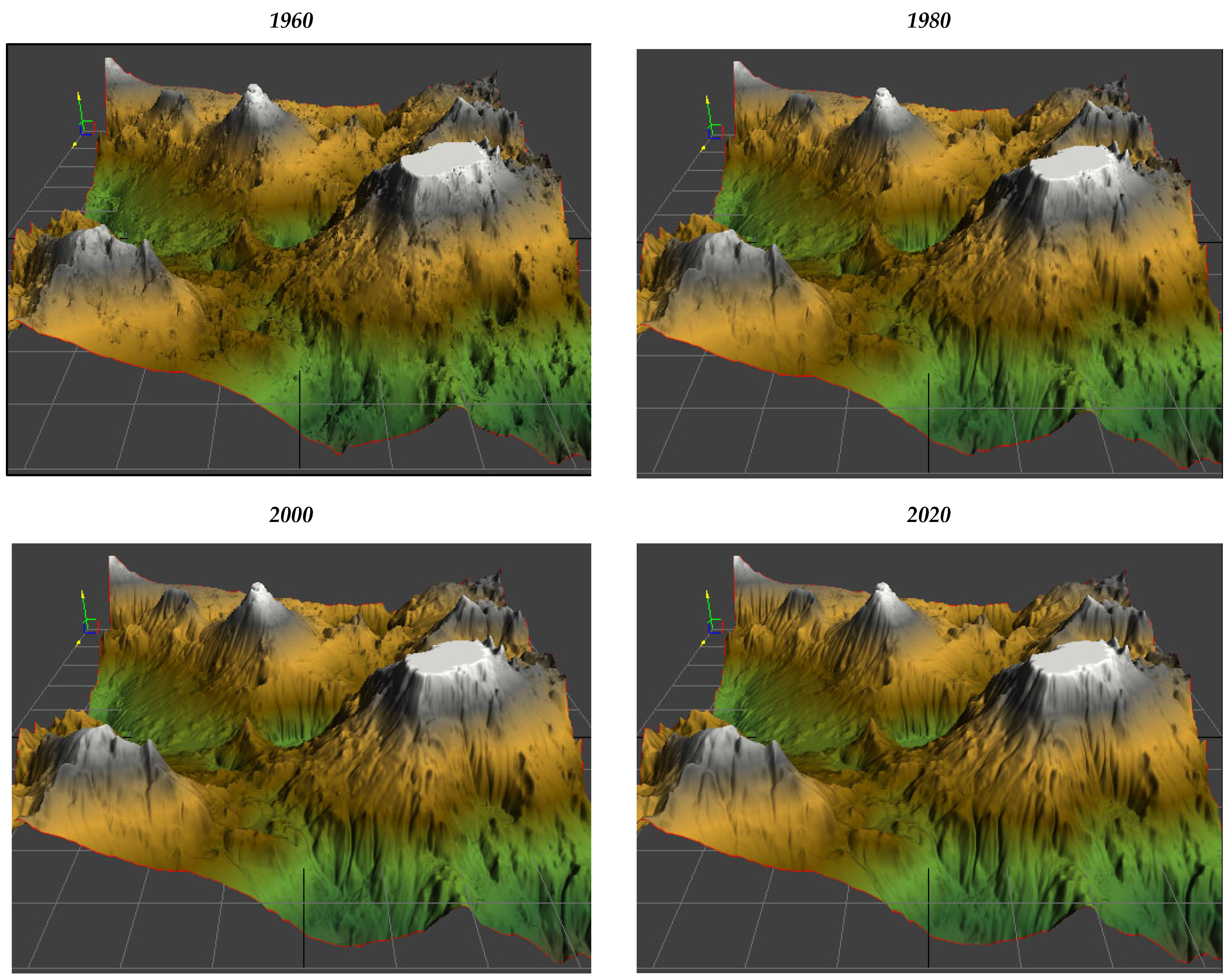
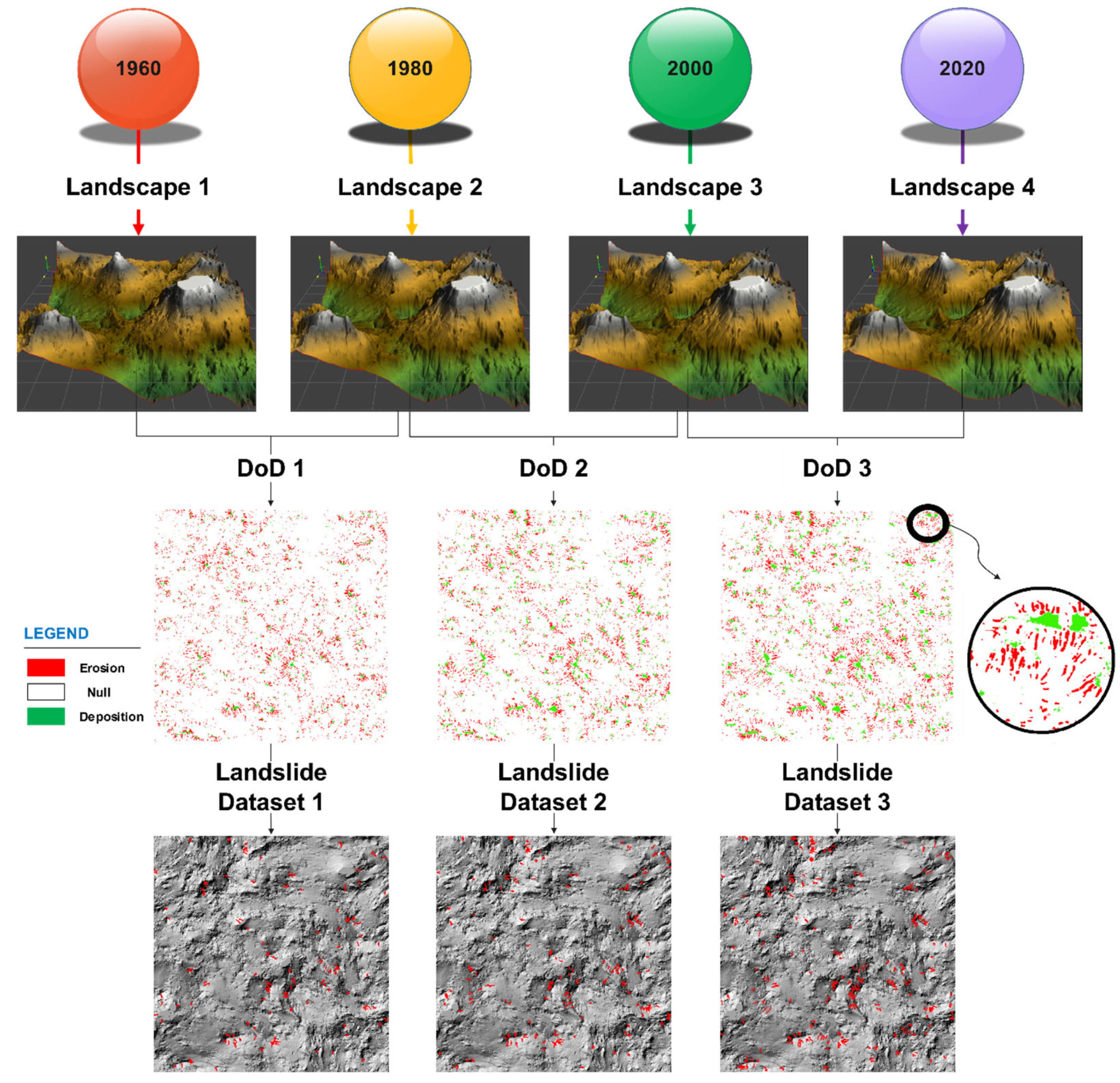


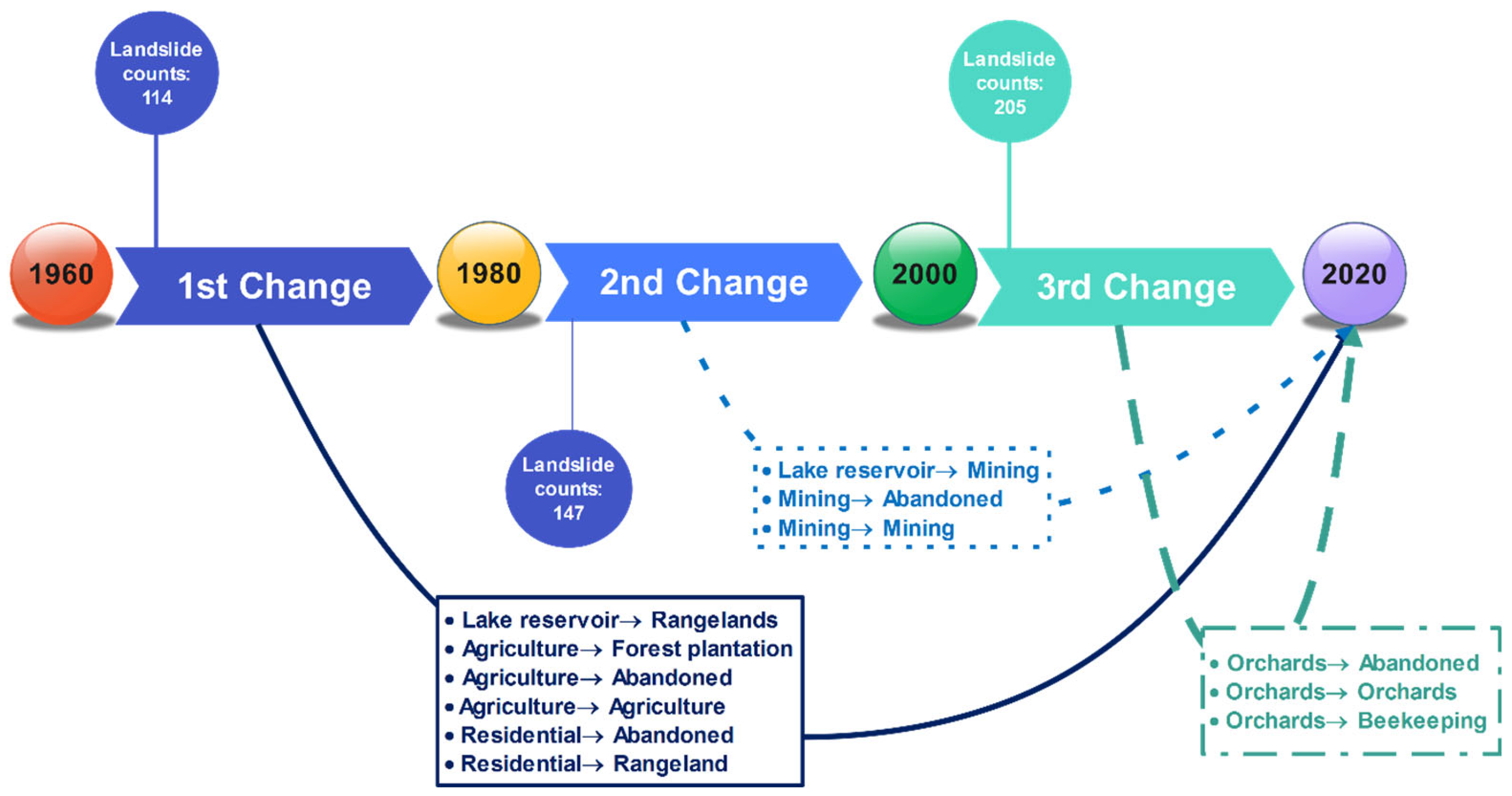
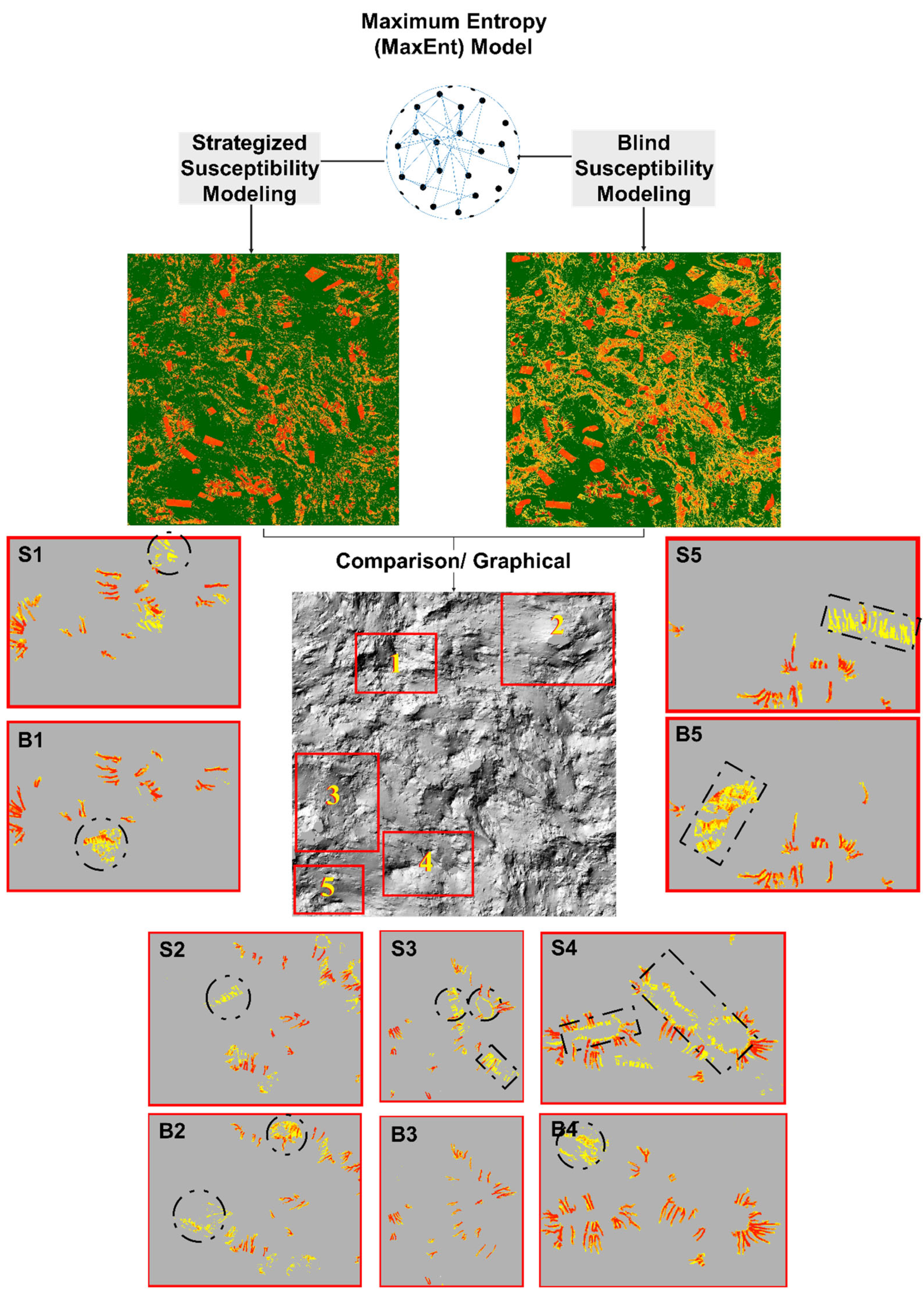
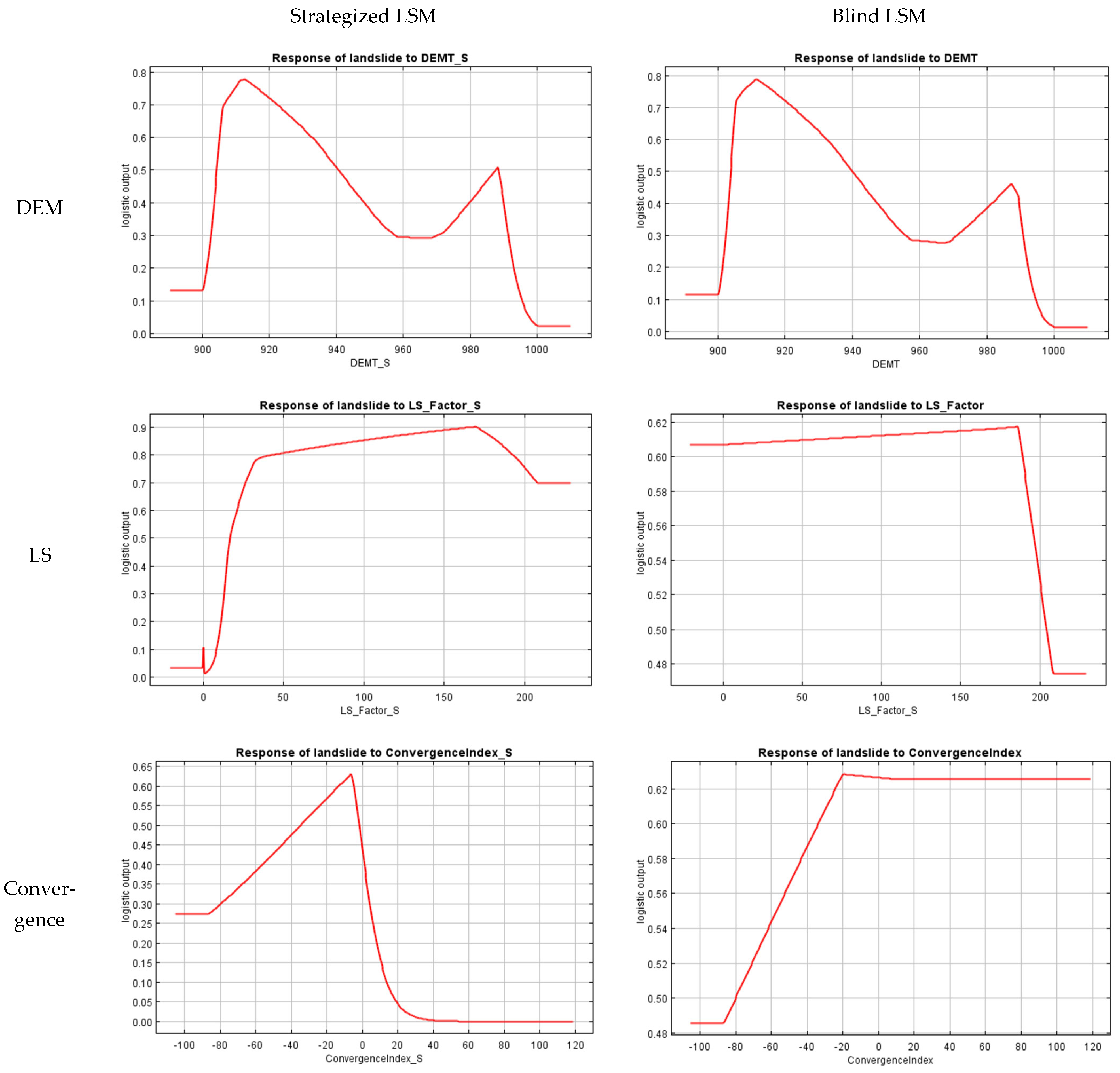
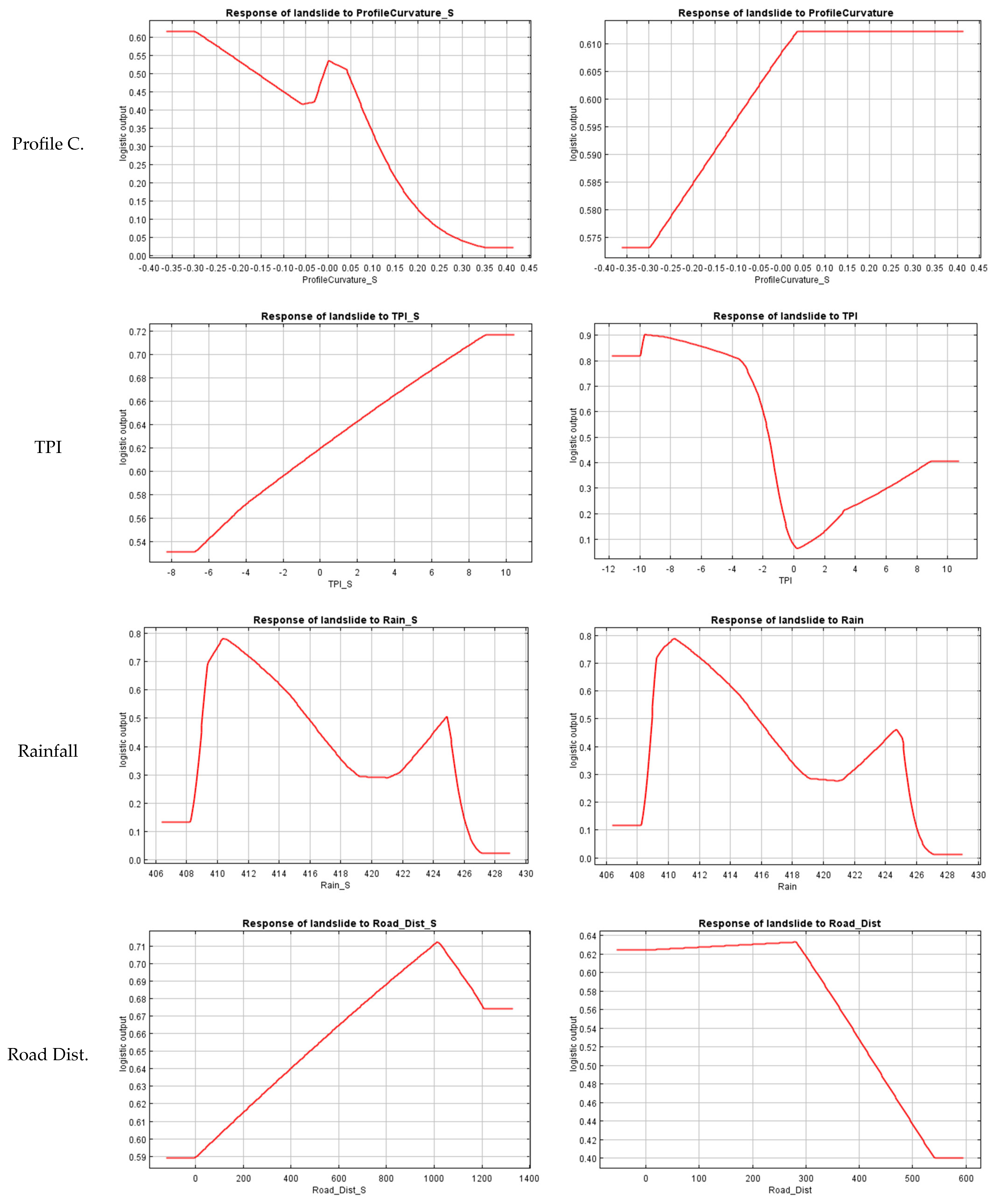
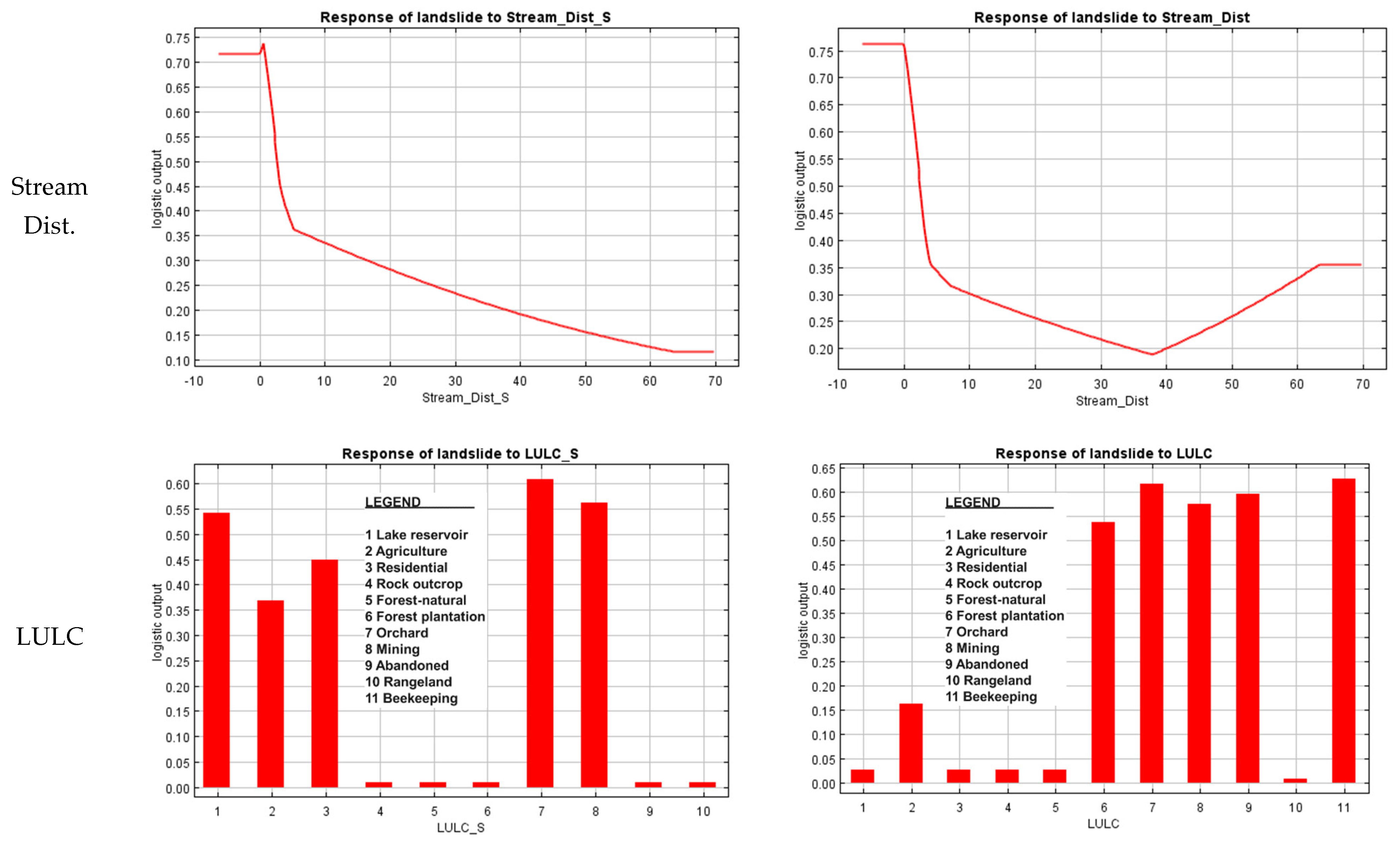
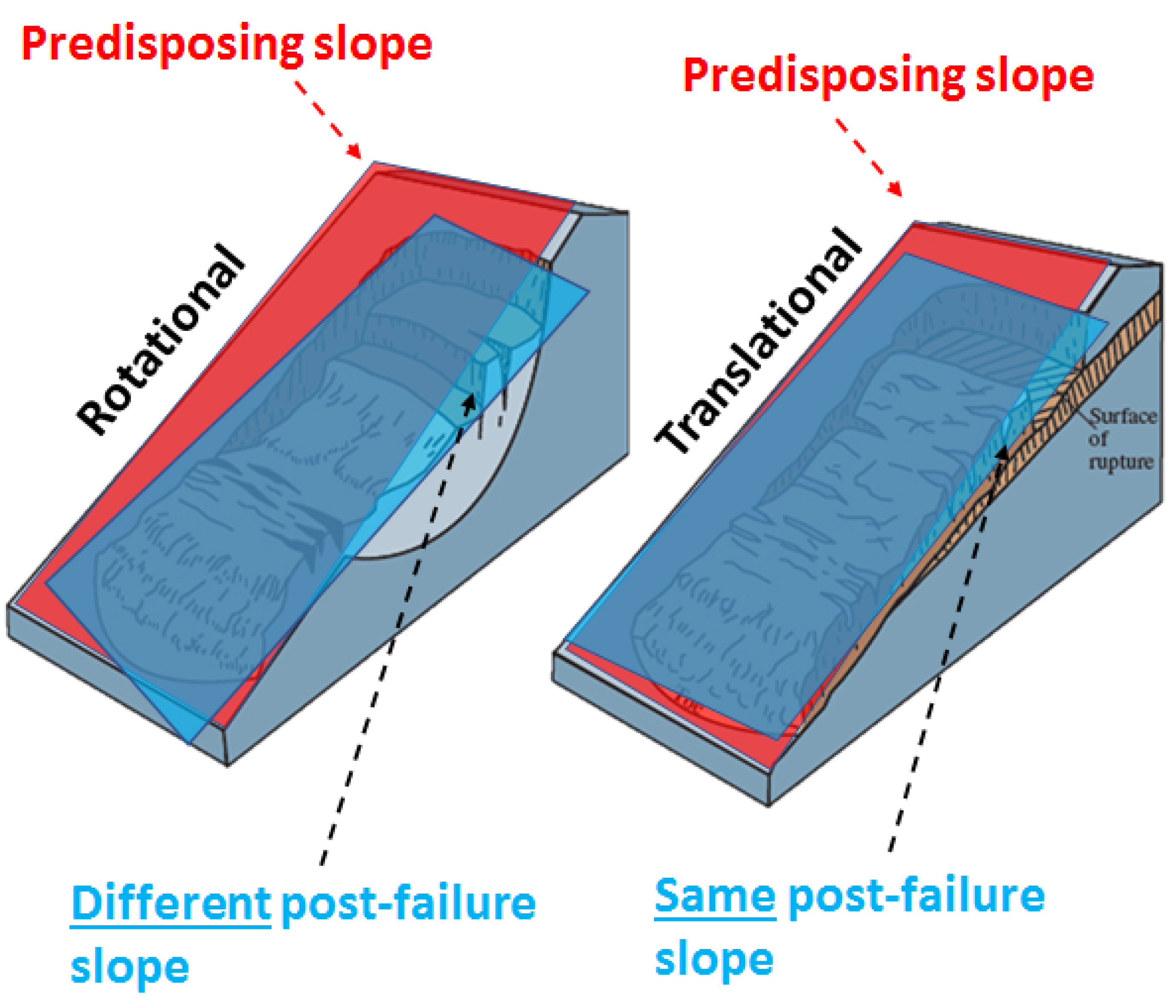
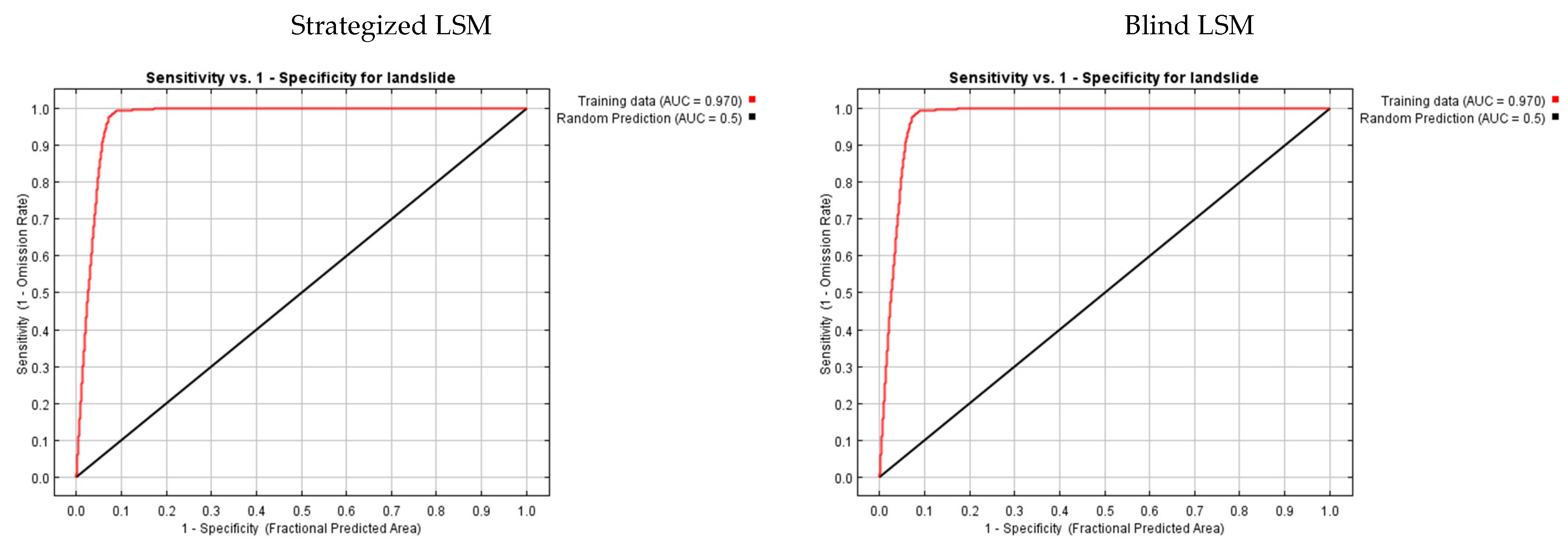
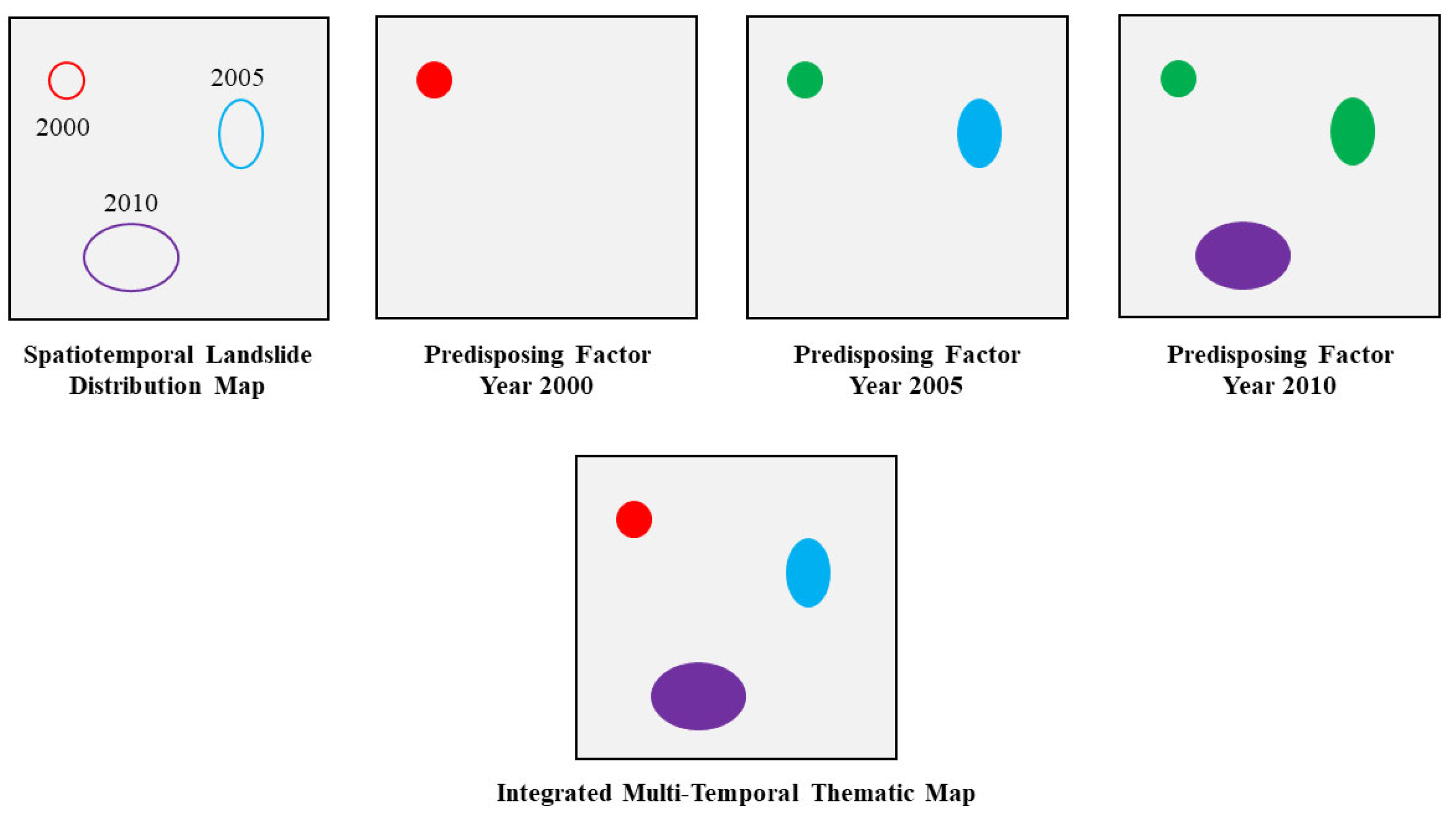
| Index | Contribution to LSM |
|---|---|
| Topographic Position Index (TPI) | Indicates each pixel’s position relative to ridges and valleys, aiding in identifying slope stability zones. |
| Curvature Index (CI) | Describes surface curvature, influencing erosion patterns and sediment deposition on slopes. |
| Topographic Wetness Index (TWI) | Combines slope and upstream catchment area to assess potential soil moisture distribution and runoff accumulation. |
| Terrain Ruggedness Index (TRI) | Quantifies surface complexity, affecting water flow retention and erosion susceptibility. |
| Plan Curvature (Pl. Curv.) | Determines flow convergence/divergence across the slope, impacting soil moisture concentration and erosion. |
| Stream Distance (St. Dist.) | Measures distance to nearest stream, affecting water accumulation and drainage pathways on slopes. |
| Slope Length (LS) | Accounts for slope steepness and length, critical for assessing erosion risk and slope stability. |
| Valley Depth (VD) | Measures the depth of valleys, influencing local drainage and sediment deposition areas. |
| Mass Balance Index (MBI) | Assesses the balance of sediment deposition and erosion, relevant for identifying landslide-prone areas. |
| Relative Slope Position (RSP) | Describes the pixel’s relative position on the slope, crucial for slope stability analysis in relation to surrounding topography. |
| Flow Accumulation (Flow Acc.) | Calculates the total drainage area, helping to identify water flow paths and potential landslide zones. |
| Stream Power Index (SPI) | Measures the potential stream energy available for sediment transport, essential in erosion-prone areas. |
| Slope (Slope) | Indicates terrain steepness, a primary factor affecting gravitational movement and landslide risk. |
| Melton Ruggedness Index (MRI) | Provides a measure of ruggedness based on elevation, impacting surface water flow and erosion susceptibility. |
| Profile Curvature (Prof. Curv.) | Describes the slope profile’s shape, which influences water flow speed and sediment transport dynamics. |
Disclaimer/Publisher’s Note: The statements, opinions and data contained in all publications are solely those of the individual author(s) and contributor(s) and not of MDPI and/or the editor(s). MDPI and/or the editor(s) disclaim responsibility for any injury to people or property resulting from any ideas, methods, instructions or products referred to in the content. |
© 2025 by the authors. Licensee MDPI, Basel, Switzerland. This article is an open access article distributed under the terms and conditions of the Creative Commons Attribution (CC BY) license (https://creativecommons.org/licenses/by/4.0/).
Share and Cite
Liu, J.; He, P.; Xiao, J.; Hu, Q.; Ren, Y.; Kornejady, A.; Gao, H. When Time Prevails: The Perils of Overlooking Temporal Landscape Evolution in Landslide Susceptibility Predictions. Remote Sens. 2025, 17, 1752. https://doi.org/10.3390/rs17101752
Liu J, He P, Xiao J, Hu Q, Ren Y, Kornejady A, Gao H. When Time Prevails: The Perils of Overlooking Temporal Landscape Evolution in Landslide Susceptibility Predictions. Remote Sensing. 2025; 17(10):1752. https://doi.org/10.3390/rs17101752
Chicago/Turabian StyleLiu, Jinping, Panxing He, Jianhua Xiao, Qingfeng Hu, Yanqun Ren, Aiding Kornejady, and Huiran Gao. 2025. "When Time Prevails: The Perils of Overlooking Temporal Landscape Evolution in Landslide Susceptibility Predictions" Remote Sensing 17, no. 10: 1752. https://doi.org/10.3390/rs17101752
APA StyleLiu, J., He, P., Xiao, J., Hu, Q., Ren, Y., Kornejady, A., & Gao, H. (2025). When Time Prevails: The Perils of Overlooking Temporal Landscape Evolution in Landslide Susceptibility Predictions. Remote Sensing, 17(10), 1752. https://doi.org/10.3390/rs17101752









